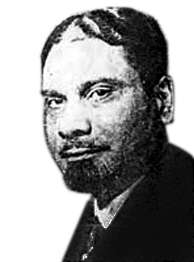Chempakaraman Pillai
| Chempaka Raman Pillai | |
|---|---|
 | |
| Born |
15 September 1891 Trivandrum, India |
| Died |
26 May 1934 Nazi Germany |
| Other names | Champak |
| Organization | Berlin Committee, Provisional Government of India |
| Movement | Indian Independence movement, Indo-German Conspiracy |
Chempakaraman Pillai, alias Venkat, was an Indian-born political activist and revolutionary.[1] Pillai lived in Germany for most of his active years, and died in Berlin in 1934.
Early life
Pillai was born into a Tamil family in Trivandrum, capital of the former kingdom of Travancore in the modern state of Kerala. Pillai had a sister named Paappaathi Ammal. She married a sculptor named Chatrapathi Pillai, whose sculpture, Kuravan Kurathi, is in the Trivandrum Museum. Paappaathi Ammal had four daughters, one of whom still resides in Trivandrum.
In Europe
Pillai attended a technical institute, pursuing a diploma in Engineering. After the outbreak of the First World War, he founded the International Pro-India Committee and based its headquarters in Zürich, appointing himself president in September 1914. During the same period an Indian Independence Committee was formed in Berlin by a group of Indian expatriates in Germany. This latter group was composed of Virendranath Chattopadhyaya, Mahatma Gandhi, Bhupendranath Dutta, A. Raman Pillai, Taraknath Das, Maulavi Barkatullah, Chandrakant Chakravarty, M. Prabhakar, Birendra Sarkar, and Heramba Lal Gupta.
In October 1914, Pillai moved to Berlin and joined the Berlin Committee, merging it with his International Pro-India Committee as the guiding and controlling institution for all pro-Indian revolutionary activities in Europe. Lala Har Dayal was also persuaded to join the movement. Soon branches sprang up in Amsterdam, Stockholm, and Washington, as well as in many other parts of Europe and the Americas.
War activities
The Indian Independence Committee ultimately became involved in the so-called Hindu-German Conspiracy along with the Ghadar Party in the United States. The German foreign office under Kaiser Wilhelm II funded the Committee's anti-British activities. Chempakaraman and A. Raman Pillai, both from Travancore and both students at German universities, worked together on the Committee. Pillai later joined with Indian National Congress chief Subhash Chandra Bose.
Pillai coined the "Jai Hind" slogan.
Many of Pillai's letters to A. Raman Pillai, then a student in the University of Göttingen, were kept by Raman Pillai's son Rosscote Krishna Pillai. The letters reveal some aspects of Pillai's life in Germany between 1914 and 1920, as does one of July 1914, calling upon Indian soldiers in the British Indian Army to rise in revolt and fight against the British.
After the end of World War I and Germany's defeat, Pillai stayed in Germany, working as a technician in a factory in Berlin; when Netaji Subhas Chandra Bose visited Vienna, Pillai met him and explained his plan of action.
Foreign Minister of Provisional Government of India
Pillai was the foreign minister of the Provisional Government of India set up in Kabul, Afghanistan on 1 December 1915, with Raja Mahendra Pratap as President and Maulana Barkatullah as Prime Minister. However, the defeat of the Germans in the war shattered the hopes of the revolutionaries, and the British forced them out of Afghanistan in 1919.
During this time, the Germans were helping the Indian revolutionaries from their own motives. Though the Indians made it clear to the Germans that they were equal partners in their fight against the common enemy, the Germans wanted to use the revolutionaries' propaganda work and military intelligence for their own purposes.
Marriage and death
In 1931, Pillai married Lakshmi Bai of Manipur, whom he had met in Berlin. Unfortunately they had a short life together, as Pillai soon fell ill. There were symptoms of slow poisoning and he went to Italy for treatment. He died in Berlin on May 28, 1934. Lakshmibai bought Pillai's ashes to India in 1935 where they were later ceremonially immersed in Kanyakumari with full state honours.[2]
References
- ↑ Mathew, K. M.; Mammen, Matthew (2009). Malayala Manorama Yearbook (in Tamil). Kottayam: Malayala Manorama Co. p. 301. ISBN 978-8-189-00412-5.
- ↑ Rose, N. Daniel (4 December 2007). "A Forgotten Fighter". The New Indian Express. Chennai. Retrieved 8 November 2014. Date also could be 27 December 2007.
External links
- Asghar Ali Engineer (2006). They Too Fought for India's Freedom: The Role of Minorities. Hope India Publications. ISBN 81-7871-091-9. Retrieved 8 November 2014.
